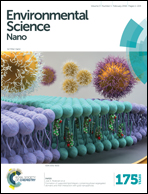Research highlights: engineering nanomaterial-based technologies for environmental applications
Abstract
Nanomaterials are currently of interest for water treatment and remediation applications because they can exhibit high adsorption capacities and high reactivity to degrade or transform contaminants. Research is ongoing to further increase the adsorption capacity of the nanomaterials and to engineer nanomaterial-based treatment systems for contaminant removal. Here, we highlight three articles that advance this field by devising and testing approaches to improve the design of nanomaterials as well as their implementation in water treatment applications. One study demonstrates a method for non-covalent surface functionalization to produce silica and magnetite nanoparticles exhibiting thiol ligands for heavy metal removal. In another study, the surface coating chemistry of manganese oxide nanoparticles is optimized to enhance their uranyl sorption capacity. Finally, we highlight research that evaluates the overall implementation of magnetite nanoparticles for removal of hexavalent chromium (Cr(VI)) from water, including the production of the nanoparticles, their efficiency in removing Cr(VI) in a reactor, and the recovery of the used NPs in a magnetic separation system.


 Please wait while we load your content...
Please wait while we load your content...